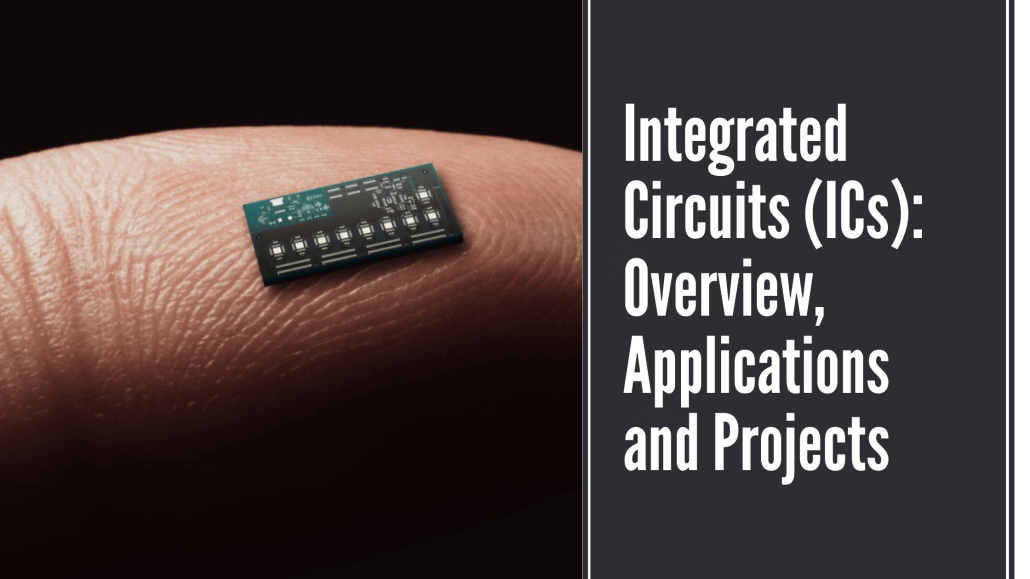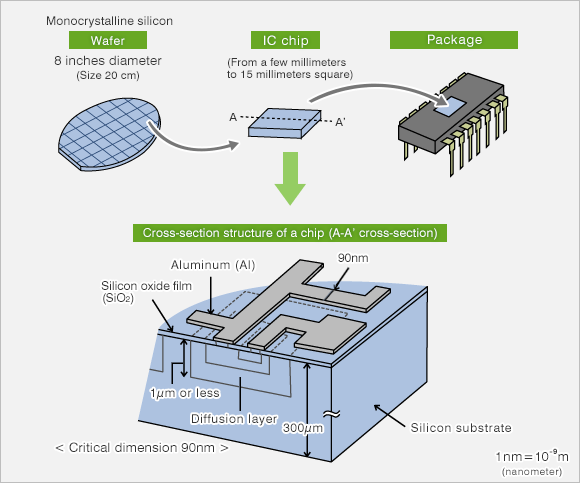Integrated Circuits (ICs): Overview, Applications and Projects
You can find integrated circuits everywhere these days, from the phone that’s in your hand to the computer you’re looking at right now. Integrated Circuits are the key to all electronics, but it can be pretty complicated to understand. Thus, in today’s article, we will be tackling what exactly is Integrated Circuits (ICs)?

Before we can jump right into our main topic for the day, let’s recap some basic knowledge to help you better understand ICs!
- Electricity: The movement of positive and negatively charged particles.
- Resistors: A passive two-terminal electrical component that implements electrical resistance as a circuit element.
- Capacitors: A passive component that stores electrical energy in an electric field.
- Transistors: A semiconductor device that’s built with three terminals for amplifying or switching electronic signals and electrical power purposes.
Feel free to click on the links above to read more about each topic! With that said, let’s look at what will be covered:
- Overview of Integrated Circuits
- Types of Integrated Circuits
- Applications of Integrated Circuits
- Integrated Circuits Recommendation
- Projects with Integrated Circuits
Overview of Integrated Circuits (ICs)
What are ICs?
Integrated Circuits (ICs) are also known as microchips or microelectronic circuit, it is a semiconductor wafer that holds thousands and millions of resistors, capacitors and transistors. It is basically an assembly of electronic components that’s fabricated as a single unit.

How do ICs work?
In order to understand how ICs work, let’s look at how it’s made. If you’re familiar with transistors, you’ll know about semiconductors. The raw material for ICs is silicon, then it is basically chemically treated or doped.
The reason why silicon is doped is that untreated silicon has a very high resistance to electrical current at room temperature. But by introducing impurities, the doped silicon then is able to conduct electricity. Moreover, the doped silicon can then act as a switch, that allows you to control the current.

Depending on the dopant (material that is introduced), the atomic structure of the silicon will change as well, resulting in either an n-type (negative) or p-type (positive) semiconductor. By putting n-type silicon and p-type silicon side-by-side, a junction will be created and that’s how ICs and other semiconductor-based components are created.
What’s inside an IC?

The above image shows how the IC is constructed for usage, from the cross-structure of a chip, you can also see that it utilises aluminium and other layers of silicon.

The image above then shows how an IC chip looks like under an X-ray through 3D rendering, it features complex structures with multiple layers that forms an IC chip.
Types of Integrated Circuits
There are actually 3 main types of ICs, though technically it’s 2, each of them opened up a lot of opportunities for new uses!
Digital ICs
A digital IC is designed to handle only voltages of specific given values. Such as binary values, where 1 and 0 stand for on and off respectively. It is said that there are more than 10 billion transistors in a digital circuit!

This type of circuit also uses digital logic gates, flip flops and multiplexes etc. They are also low cost, which makes it pocket-friendly for students. Some examples of digital IC are MPU (microprocessors), MCU (microcontrollers) and logic ICs.
Analog ICs
Analog ICs are also known as linear ICs, they are a lot simpler than the previous digital IC. This type of IC uses very few components and basically tackles continuous signals, that collects signals from the environment or just sends signals back continuously.

Analog ICs are also capable of filtering and act as sensors, it is able to control a device in response to the changes in the environment.
Mixed Signals
As its name suggests, mixed signals simply combine both digital and analog integrated circuits that we have discussed earlier. You might have heard of Analog-to-Digital Converter (ADC) and Digital-to-Analog Converter (DAC) before, this is only possible if mixed signals are used! You can also find mixed signals in timing or clock ICs.

If you’re interested to learn more about ADCs, be sure to check out Analog-to-Digital Converter (ADC): Reading Raspberry Pi Analog!
Application of Integrated Circuits
Just as I’ve mentioned in the beginning, you can find ICs in every electronic device you’ve seen or own before! But let’s look at a few applications of ICs today.
Radar

As we all know, radar is an electromagnetic sensor that uses radio waves to detect the location and range of a target. In order to collect that data, the radar system would require an IC, specifically an analog IC.
Temperature sensor

Depending on the temperature sensor, they can utilise either digital or analog IC to help measure the change in temperature and then converts the collected data into electronic data to record or monitor the change in temperature.
Integrated Circuits Product Recommendation
Interested in getting some IC products for yourself? Seeed got your back! Seeed offers a wide range of products that utilises IC chips, let’s look at some of them.
Grove – Temperature Sensor ($2.90)

If you’re interested in getting a temperature sensor to try out, our Grove – Temperature Sensor is affordable, suitable for beginners as it comes with a guide and it uses a thermistor to measure ambient temperature.
How it works is the resistance will change the output of the voltage divider as it is measured by the analog input pin which will then be converted to a temperature value.
We highly recommend all of our Grove modules if you’re interested! We offer more than 300 Grove modules which can be daunting for many, but not fret! Click here for our selection guide and click here to purchase one for yourself!
Seeeduino V4.2 ($6.90)

I’m sure you already know that Single Board Computers (SBCs) require an IC chip to function, thus we will not miss out on the chance to recommend our hot item! If you’ve tried before an Arduino UNO, you’ll definitely love our Seeeduino V4.2 as well since it’s much more affordable!
Seeeduino V4.2 is an Arduino-compatible board that uses the same microprocessor as an Arduino UNO. It features a 14 Digital I/O Pins, 3 on-board Grove connectors, 3.3/5V system operation power switch. Moreover, there is no need to fuss about jumper wires and soldering due to our Grove modules. You would definitely need this if you’re interested in trying out an affordable yet user-friendly SBC!
Be sure to check out our other Seeeduino products, all of them are Arduino compatible! Click here to find out more.
Projects with ICs
If you own an IC chip or is interested in building one for yourself, you can check out some of the projects below!
Build Your Own 555 Timer

Interested in building your own IC chip? The 555 timer is a popular and versatile IC chip that allows you to use in many projects. This project shows you how to build your 555 timer using only resistors and transistors!
What you’ll need:
- breadboard
- capacitor
- 2 1k ohm resistors
- 2 10k ohm resistors
- 11 4.7k ohm resistors
- 11 2n3904 NPN transistors or similar
- 9 2n3906 PNP transistors or similar
Sounds fascinating? Click here to find out more!
How to Make an Electronic Piano With a 555 IC

Ever thought of building your very own toy piano? This project shows you how you can build a toy piano on a perf board using 555 timer IC and a few components!
What you’ll need:
- 6 x 1K resistors
- 6 x small buttons
- 1 x 10k resistor
- 10u and a 100n capacitor
- 555 timer chip
- 8r speaker
- small piece of perf board
- battery clip and switch
- wire leads
- solder + iron
- 470-ohm resistor
- A led
If this project is up to your alley, click here for the detailed tutorial!
Summary
And that’s all on Integrated Circuits! Did you learn something new about it? We’ve discussed how ICs are made, its applications as well as some interesting projects for you to try out!
Seeed also offers a Fusion Service where you’ll be able to customize and manufacture all your circuit designs and creations, so be sure to check us out!
We hope that this article has helped you understand ICs and if you’re interested to learn more about ICs, do check out the links down below!
Suggested Readings
- Basic Knowledge, Circuit and Application of Operational Amplifier (op amp)
- SPI – Introduction to Serial Peripheral Interface
- I2C Communication – All about I²C with Diagrams
- UART vs I2C vs SPI – Communication Protocols and Uses